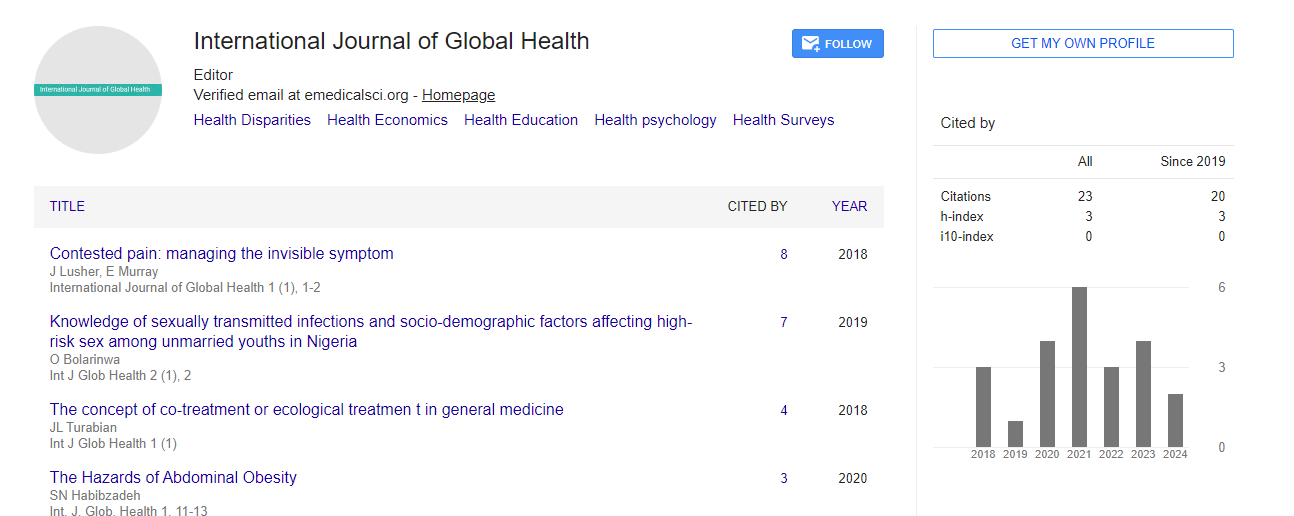Perspective, Int J Glob Health Vol: 7 Issue: 3
Understanding Multiple Myeloma: Symptoms, Diagnosis and Treatment
Michael Morris*
1Department of Clinical Therapeutics, University of Athens, Athens, Greece
*Corresponding Author: Michael Morris,
Department of Clinical Therapeutics,
University of Athens, Athens, Greece
E-mail: mdimop@med.gr
Received date: 26 August, 2024, Manuscript No. IJGH-24-148988;
Editor assigned date: 28 August, 2024, PreQC No. IJGH-24-148988 (PQ);
Reviewed date: 11 September, 2024, QC No. IJGH-24-148988;
Revised date: 18 September, 2024, Manuscript No. IJGH-24-148988 (R);
Published date: 25 September, 2024, DOI: 10.4172/Ijgh.1000209.
Citation: Morris M (2024) Understanding Multiple Myeloma: Symptoms, Diagnosis and Treatment . Int J Glob Health 7:3.
Abstract
Description
Multiple Myeloma (MM) is a hematologic malignancy characterized by the clonal proliferation of malignant plasma cells in the bone marrow. This condition accounts for approximately 1% of all cancers and around 10% of hematologic malignancies. The pathophysiology of multiple myeloma is complex, involving genetic mutations, changes in the bone marrow microenvironment and immune system dysregulation. Understanding the disease's biology, clinical presentation, diagnostic approaches, treatment options and ongoing research is essential for improving patient outcomes. Multiple myeloma originates from a single clone of B cells that undergoes malignant transformation, resulting in the overproduction of monoclonal immunoglobulins (Mproteins). Bone Marrow Infiltration result in malignant plasma cells accumulate in the bone marrow, disrupting normal hematopoiesis and leading to anemia, thrombocytopenia and leukopenia.
The proliferation of myeloma cells produces osteoclast-activating factors, resulting in bone resorption and lytic lesions. Patients often experience bone pain and an increased risk of fractures. Renal impairment leads to excessive production of light chains (part of the immunoglobulins) can lead to kidney damage, known as light chain cast nephropathy, contributing to renal insufficiency. The immune system is compromised due to the overproduction of ineffective antibodies and a decrease in normal immunoglobulin production, resulting in increased susceptibility to infections. Patients with multiple myeloma may present with a variety of symptoms. Hypercalcemia can occur due to increased bone resorption, leading to symptoms such as nausea, vomiting and confusion. In renal dysfunction patients may exhibit signs of renal impairment, including fatigue, weakness and reduced urine output. Fatigue, pallor and weakness are common due to reduced red blood cell production. Patients often report bone pain, especially in the back, ribs and pelvis and may experience pathological fractures.
Diagnosis of multiple myeloma
Complete Blood Count (CBC) may reveal anemia and thrombocytopenia. Serum Protein Electrophoresis (SPEP) detects monoclonal proteins in the blood. Urine Protein Electrophoresis (UPEP) identifies monoclonal proteins in the urine. Free Light Chain.
Assay measures free kappa and lambda light chains, aiding in diagnosis and monitoring. A definitive diagnosis is confirmed by identifying at least 10% clonal plasma cells in the bone marrow. Xrays, MRI, or CT scans may be utilized to assess for lytic bone lesions and to evaluate the extent of skeletal involvement. Cytogenetic analysis identifies specific genetic abnormalities associated with prognosis.
Treatment of multiple myeloma
The management of multiple myeloma has evolved significantly over the past two decades, with the introduction of novel therapies that have improved outcomes for patients. Treatment approaches are generally categorized into several phases. Induction therapy aims to achieve the best possible response before stem cell transplantation or maintenance therapy.
Combination therapy: The use of proteasome inhibitors (e.g., bortezomib, carfilzomib), immunomodulatory drugs (e.g., thalidomide, lenalidomide) and dexamethasone is common in induction regimens.
Stem cell transplantation: For eligible patients, Autologous Stem Cell Transplantation (ASCT) is a key treatment option. This involves collecting the patient’s stem cells, administering high-dose chemotherapy and reinfusing the harvested stem cells to restore hematopoiesis. ASCT can lead to prolonged remission and improved survival rates.
Maintenance therapy: After achieving a response to induction therapy and/or transplantation, maintenance therapy is often initiated to prolong remission. This may involve low-dose lenalidomide or other agents aimed at reducing the risk of relapse.
Relapsed/refractory myeloma: Newer therapies, such as monoclonal antibodies (e.g., daratumumab) and CAR T-cell therapy, are being increasingly utilized. Participation in clinical trials offers access to emerging therapies and novel combinations, potentially providing options for patients who have exhausted standard treatments.
In addition to specific treatments for multiple myeloma, supportive care is essential to manage symptoms and complications. Effective pain control is essential, utilizing analgesics, physical therapy and, in some cases, radiation therapy for painful bone lesions. Hydration, avoiding nephrotoxic agents and addressing hypercalcemia are vital in preserving kidney function. Due to immunosuppression, patients may require prophylactic antibiotics and vaccinations to reduce the risk of infections. Providing psychological support and counseling services can help patients cope with the emotional impact of their diagnosis and treatment.
Conclusion
Multiple myeloma is a complex malignancy that poses significant challenges in diagnosis, treatment and management. Advances in understanding the disease's biology and the introduction of novel therapies have improved outcomes for many patients. Ongoing research and clinical trials continue to discover new treatment modalities, aiming to further enhance survival rates and quality of life. A multidisciplinary approach that includes comprehensive care, patient education and psychosocial support is essential in managing multiple myeloma effectively.
 Spanish
Spanish  Chinese
Chinese  Russian
Russian  German
German  French
French  Japanese
Japanese  Portuguese
Portuguese  Hindi
Hindi 
